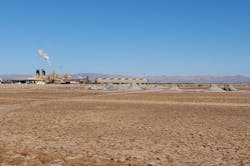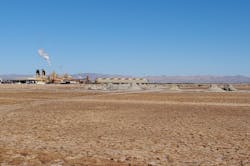Eleven commercial plants near California’s Salton Sea generate geothermal electricity by pumping hot fluids from underground and converting that heat into electricity. The plants then reinject the cooled fluid back underground, but that brine contains lithium. In fact, some geologists believe the Salton Sea geothermal field and its brine holds enough lithium to meet all of America’s domestic battery needs for electric vehicles, with enough left over to export some of it.
To determine if it’s possible to mine the brine for lithium cleanly, the DOE’s Geothermal Technologies Office is granting $1.2 million to Lawrence Berkeley National Laboratory, UC Riverside, and Geologica Geothermal Group, Inc. They will work together to quantify and characterize the lithium in the Salton Sea’s hypersaline geothermal reservoir.
This will be the first scientific effort to map out California’s so-called “Lithium Valley” and try to understand the mineral-rich underground brine at the Salton Sea geothermal system. Goals for the project include finding the sources of lithium and determining whether the rocks will “recharge” the brine with lithium after it has been extracted and the fluid reinjected.
The team will also investigate environmental impacts to quantify how much water and chemicals will be needed for lithium extraction, the air quality during extraction, and if the process could cause seismic activity.
“The Salton Sea system is the primary geothermal resource for lithium in the U.S.,” says Pat Dobson, the Berkeley Lab scientist leading the project. “But there is a wide range of estimates in terms of the size of the resource, and also not a great understanding of where the lithium comes from, the rate at which it would decline over time with extraction of lithium from the geothermal brines, and whether it would be replenished by the remaining lithium in the host rocks.”
Currently, most of the world’s lithium is mined from open pit mines, which are common in China and Australia, or extracted from salt deposits and salt lake flats. In the South American salt flats, lithium is extracted by pumping up shallow groundwater to flood the area, letting it evaporate over a year or two, then separating out the lithium from what remains.
But these methods have serious environmental issues. “We think geothermal lithium is one of the least environmentally harmful ways to obtain lithium,” says Dobson. We want to understand how to mitigate any environmental side effects to make it even more benign.”
UC Riverside geochemist Michael McKibben, who has been studying the Salton Sea geothermal field since the 1970s, believes there can be a lot of lithium in the Salton Sea area. “If you do a back-of-the-envelope calculation, you can convince yourself there’s somewhere between 1 and 6 million metric tons of lithium in that field,” he says. “That would be the largest brine source of lithium in the world, bigger than any individual South American salt deposit. That translates into 50 to 100 years’ worth of lithium production.”
The team will map out where the lithium is located within the reservoir rocks, and what form it’s in. This geochemical characterization will then be incorporated into models to assess the rate of resupply of lithium to geothermal fluids.
This work will complement geochemical studies being done by European researchers investigating the use of geothermal brines as a source of lithium.
Several companies already have pilot operations at the Salton Sea to extract lithium, including Berkshire Hathaway Energy and Controlled Thermal Resources. (Berkeley Lab has projects with both under grants from the California Energy Commission.)
The vision is that lithium from the geothermal field near the Salton Sea will eventually form the basis of a battery industry in the U.S. and spark economic growth in Imperial County, the California county with the lowest per capita income.


